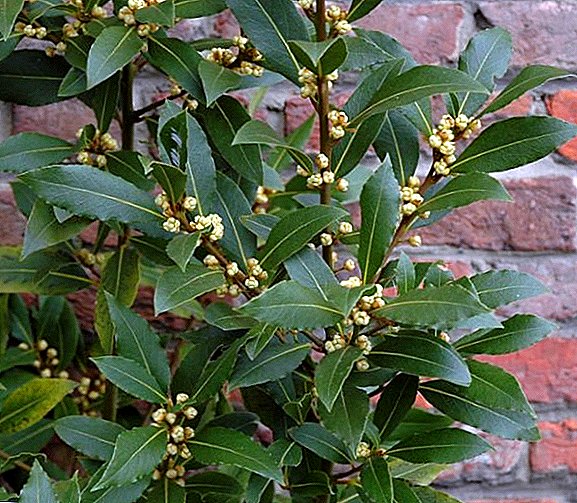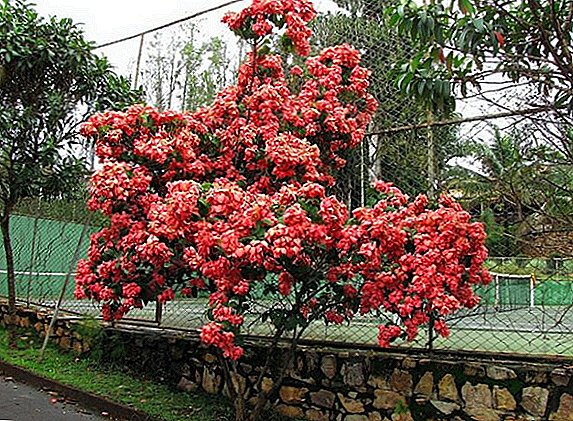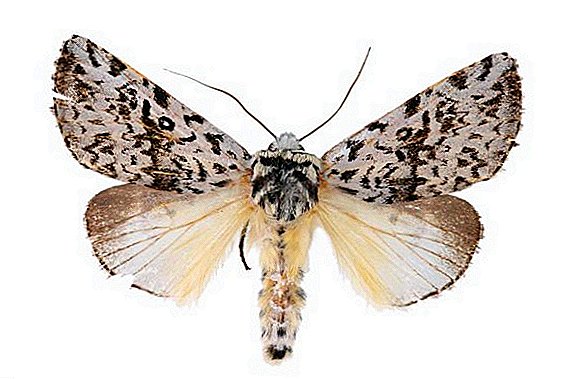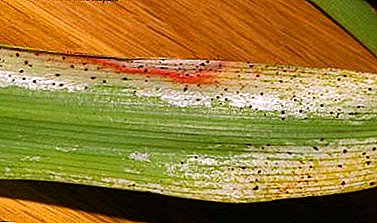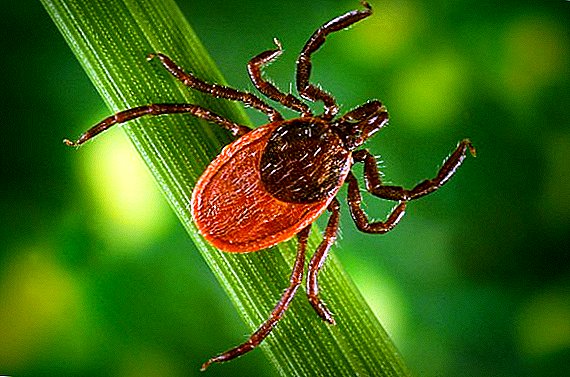 Pliers refer to arachnid animals. In our environment, they are very common. Ticks can be found in forests, meadows, river banks and lakes, in city parks, as well as at the cottage. The danger of these pests is that some of their species transmit very serious diseases through a bite to a person. In the article we will look at how to protect the dacha from ticks, how to deal with a pest and what to do in cases of a tick bite.
Pliers refer to arachnid animals. In our environment, they are very common. Ticks can be found in forests, meadows, river banks and lakes, in city parks, as well as at the cottage. The danger of these pests is that some of their species transmit very serious diseases through a bite to a person. In the article we will look at how to protect the dacha from ticks, how to deal with a pest and what to do in cases of a tick bite.
What does a tick look like?
Today, there are about 54 thousand species of ticks. Basically, their sizes range from 0.2 mm to 3 mm, some representatives can grow up to 5 mm. The body is solid or divided into the head and belly. Move with your legs. In adult representatives, as a rule, there are 4 pairs of hind legs, the larvae move with the help of six legs.
The legs consist of the following parts:
- pelvis;
- swivel;
- hips;
- knees;
- lower leg;
- paws.
Claws and suckers are placed on the legs. The first two rows of chelate appendages form the mouthparts. They are the mites pierce the skin of the victim and feed. In the simplest species, these pairs of claws are free, but they mostly grow together with the base and form a head that connects to the body. Most species have two pairs of eyes, some representatives of the visual organs in general may not be.
Did you know? Females absorb much more blood than males. Therefore, the body of well-fed females increases in size by a couple of millimeters, and the size of the males practically does not change.
 The body of pests is covered with chitin. In males, he covers the entire body, and in females - 1/3. Chitin can be soft, leathery or hard, like a shell. In general, the torso of animals has an oval shape, in some species it may sharpen from behind or, conversely, more rounded than from the front. The color spectrum of ticks is different: brown, red, beige, gray.
The body of pests is covered with chitin. In males, he covers the entire body, and in females - 1/3. Chitin can be soft, leathery or hard, like a shell. In general, the torso of animals has an oval shape, in some species it may sharpen from behind or, conversely, more rounded than from the front. The color spectrum of ticks is different: brown, red, beige, gray.
What is the danger of ticks?
Ticks are dangerous because they can be carriers of diseases dangerous to humans.
These include:
- encephalitis;
- Lyme disease;
- tularemia;
- fever;
- tick fever.
However, not all species are carriers of such ailments. In fact, among the dangerous for humans, there are only 7 species, the most aggressive include encephalitis, ixodic, argas, scabies, subcutaneous. Most of the other representatives, getting on the skin of a person, cause only unpleasant itching or irritation.
At the same time, most species of ticks are pests that infect plants and animals. The most common and violent dacha pest is spider mite. It feeds on plant sap, and is also a carrier of root and gray rot.
 It can inhabit any species of plants, including indoor. In addition, there are types of ticks that affect certain cultures: lime, grape, pear, walnut, plum, apple, etc. They mainly settle under foliage, on fruits and flowers. Ticks suck out all the nutrients from plants, which leads to wilt, decrease in yield and, ultimately, plant death.
It can inhabit any species of plants, including indoor. In addition, there are types of ticks that affect certain cultures: lime, grape, pear, walnut, plum, apple, etc. They mainly settle under foliage, on fruits and flowers. Ticks suck out all the nutrients from plants, which leads to wilt, decrease in yield and, ultimately, plant death.
Important! If you find a tick bite, be sure to seek medical attention to rule out the possibility of contracting dangerous diseases.
Also many types of ticks attack animals. As a result, the latter begin to hurt and may die. Some ticks are harmless to the animals themselves, but through them they can carry diseases to humans.
How to detect ticks on the site
You can inspect the site for the presence of ticks by yourself, without resorting to the services of professional services. For this purpose, you need a wooden stick about a meter in size and a piece of wafer material of white color (meter per meter). The fabric should be tied with two ends to a stick so that the resulting product resembles a flag.
Did you know? To lure pests, it is recommended to soak up the fabric afterwards of a person or an animal.
 The stick with the material must be slowly dragged over the grass or bare soil (when carrying out an inspection in early spring). Inspection should be carried out after the morning dew has come down. Make sure that the fabric does not curl. Walk through the site is recommended several times, conducting material on both sides. Periodically check the fabric for ticks. If pests are detected, they should be carefully removed from the material with tweezers and placed in an airtight container. From this point on, it is time to think about the destruction of ticks at the dacha.
The stick with the material must be slowly dragged over the grass or bare soil (when carrying out an inspection in early spring). Inspection should be carried out after the morning dew has come down. Make sure that the fabric does not curl. Walk through the site is recommended several times, conducting material on both sides. Periodically check the fabric for ticks. If pests are detected, they should be carefully removed from the material with tweezers and placed in an airtight container. From this point on, it is time to think about the destruction of ticks at the dacha.
Important! Before checking, you need to take care of how to protect yourself from ticks. To do this, it is necessary to close all parts of the body with clothes, and to open the open areas with a special spray, to hide the hair in a headdress. It is desirable to use light-colored clothes.
Preventive measures against ticks
Than to get rid of ticks, it is better not to allow them to appear.
In order to reduce the risk of pests on the summer cottage, the following preventive measures should be carried out:
- regularly remove weeds and mow the grass;
- get rid of dry leaves and mowed grass;
- prevent the occurrence of rodents on the site;
- around the site to spread crushed stone or sawdust at least half a meter wide, in order to prevent the migration of ticks from adjacent areas.
Did you know? Some plants have a natural insecticide against ticks. These include: chamomile, thyme, garlic, lavender, mint. Planting such plants on the site, you will repel pests.
Biological treatment of ticks
 Biological agents against ticks have several advantages. And the main one is that they are less toxic than chemical preparations for the destruction of ticks. If chemical agents have contraindications for use during flowering or fruiting of plants, then biological preparations have no such contraindications. Biological agents are also not dangerous for plants and beneficial insects. For biological treatment, you can use special preparations, as well as self-made decoctions of herbs, the smell of which repels ticks.
Biological agents against ticks have several advantages. And the main one is that they are less toxic than chemical preparations for the destruction of ticks. If chemical agents have contraindications for use during flowering or fruiting of plants, then biological preparations have no such contraindications. Biological agents are also not dangerous for plants and beneficial insects. For biological treatment, you can use special preparations, as well as self-made decoctions of herbs, the smell of which repels ticks.
The most popular biological drugs for ticks include:
- "Apollo";
- "Akarin";
- "Fitoverm";
- Vermitek;
- "Actofit".
The most effective is considered "Vermitek". It is active against all types of ticks, larvae and adults. In addition, he has the longest protection period of the site - about a month. It is harmless to plants, beneficial insects, bees, resistant to rain.
Important! With a large number of ticks, it is recommended to re-treat the area with a preparation in a week.
"Apollo" refers to the most harmless drugs. However, it only destroys the larvae and eggs of the pest. He does not kill adult representatives, but sterilizes them, which leads to the gradual destruction of settled ticks. "Actofit" paralyzes ticks. At first they stop eating, and after 3 days they die. However, when processing this drug should isolate the bees for a day. "Akarin" is active against spider mites, which settled on vegetable plants and currants.  Processing of the site from ticks is carried out by spraying in the morning (after the dew subsides and up to 9 hours) or in the evening (after five). Dilute the solution must be strictly according to the instructions. To treat the site, you can also use the infusion of wormwood, onions or garlic. To prepare a decoction of wormwood, 2 kg of finely chopped herbs should be poured over 10 liters of water and left for 48 hours. Then boil for half an hour and bring to 10 liters with cold water. Before processing the mixture is diluted with water in a ratio of 1: 2.
Processing of the site from ticks is carried out by spraying in the morning (after the dew subsides and up to 9 hours) or in the evening (after five). Dilute the solution must be strictly according to the instructions. To treat the site, you can also use the infusion of wormwood, onions or garlic. To prepare a decoction of wormwood, 2 kg of finely chopped herbs should be poured over 10 liters of water and left for 48 hours. Then boil for half an hour and bring to 10 liters with cold water. Before processing the mixture is diluted with water in a ratio of 1: 2.
Did you know? The female tick lays about 17 thousand eggs at a time. Eggs are laid in the soil. Therefore, it is recommended to process not only grass, plants, but also bare soil.
For the preparation of garlic infusion need to chop two heads of garlic and pour a liter of water. Infuse the mixture for 5 days in a dark place. Before spraying, dilute with water in a 1: 1 ratio. You can also pour 100 grams of onion peel and insist five days. Then process the resulting strained infusion area.
Chemical treatment of the dacha from ticks
With the ineffectiveness of biological agents or a large number of pests, it is recommended to spray the area from ticks with chemical preparations. The advantages of chemical processing include rapid exposure, complete destruction of larvae and adults. However, at the time of spraying and even a couple of days after isolating the bees, animals. After processing it is necessary to sustain a certain period before harvesting.
Important! Do not treat the site with chemicals more than twice.
The most popular chemical poisoning from ticks include:
- Sunmite;
- "Envidor";
- "Bi-58";
- "Tiovit Jet".
 The longest protection period has "Sunmite" (about one and a half months). "Tiovit Jet" is considered the least toxic, but the term of its protective action does not exceed two weeks. On average, the waiting period after processing to harvest is a month (cucumbers - a fortnight). When working with chemicals, it is important to first familiarize yourself with when tick milling can be done. Spraying is carried out only in the morning and evening. Many drugs are forbidden to use during the flowering period of plants. Spraying chemicals is not recommended as a preventive measure. Work carried out after the identification of pests.
The longest protection period has "Sunmite" (about one and a half months). "Tiovit Jet" is considered the least toxic, but the term of its protective action does not exceed two weeks. On average, the waiting period after processing to harvest is a month (cucumbers - a fortnight). When working with chemicals, it is important to first familiarize yourself with when tick milling can be done. Spraying is carried out only in the morning and evening. Many drugs are forbidden to use during the flowering period of plants. Spraying chemicals is not recommended as a preventive measure. Work carried out after the identification of pests.
When working with chemicals it is very important to observe safety measures:
- do not use food containers to dilute the solution;
- protect all parts of the body with clothing;
- use gloves and a protective mask (or a gauze bandage and goggles);
- hair hide under a headdress;
- after processing the area use a tablet of activated carbon.
Did you know? Many species of ticks in a state of hunger eat their relatives.
What to do if a tick has stuck
 Knowing how to pull a tick is very important. If this is done incorrectly, there is a risk that pathogens of dangerous diseases will enter the blood or the parasite's head will remain in the skin. You can pull the tick with your fingers or thread. Before removing the parasite, hands should be wrapped with gauze. Ticks should be gently wrapped with the thumb and forefinger as close as possible to the proboscis and gently twisted with rotating movements. This process can also be carried out with tweezers, which must be held perpendicular to the location of the parasite.
Knowing how to pull a tick is very important. If this is done incorrectly, there is a risk that pathogens of dangerous diseases will enter the blood or the parasite's head will remain in the skin. You can pull the tick with your fingers or thread. Before removing the parasite, hands should be wrapped with gauze. Ticks should be gently wrapped with the thumb and forefinger as close as possible to the proboscis and gently twisted with rotating movements. This process can also be carried out with tweezers, which must be held perpendicular to the location of the parasite.
Important! In no case do not press hard on the tick, otherwise you can tear off the trunk from the proboscis or provoke the injection of a large amount of toxins into the blood. Also, do not need to handle the pest oil.
 The removed tick should be placed in an airtight container and a piece of damp cotton wool or several blades of grass should be placed there to create a moist environment. Then it must be taken to the laboratory to find out the type of tick, whether it is dangerous to humans. It is necessary to hand over a pest for research no later than on the second day. Even if the tick was not kept alive, it still needed to be taken to the laboratory. The bite site is necessarily treated with iodine. If during a month you feel unwell or your temperature has risen, your bite has reddened or swollen - you should seek medical help.
The removed tick should be placed in an airtight container and a piece of damp cotton wool or several blades of grass should be placed there to create a moist environment. Then it must be taken to the laboratory to find out the type of tick, whether it is dangerous to humans. It is necessary to hand over a pest for research no later than on the second day. Even if the tick was not kept alive, it still needed to be taken to the laboratory. The bite site is necessarily treated with iodine. If during a month you feel unwell or your temperature has risen, your bite has reddened or swollen - you should seek medical help.
Now you know how to detect pests in your country house, how to independently treat the area from ticks and what to do in case of a bite. You can, of course, take advantage of the services of special services, but if you correctly follow all the instructions and tips presented, you can do everything on your own and save a lot of money.




